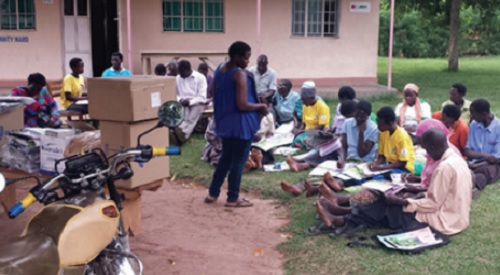
Figures by a local NGO; THETA, show that only 60,000 of the 180,000 VHTs working as volunteers are trained. Many are not accountable to any qualified medical supervisor who monitors their work.
That is unlikely to change because the CHEWs will also be trained by UNICEF, the Swedish International Development Agency, and UNFPA.
Olengo says his bicycle – the only item he ever received to do his job, is also getting old. It is unlikely he will get a new one soon.
Part of the reason is that when we spoke, Olengo did not know about the government’s plan to introduce CHEWs.
That is possibly because, according to Dr. Olaro, the CHEWS programme is recruiting people who must have attained at least an Ordinary Level Certificate of Education.
“The best candidates are those that people run to when they need help. When you go to those parishes they know them and can suggest for you names of people they trust,” he says, “Trust is a very important aspect of treatment.”
Although Olengo scores highly on trust, the 40-year old farmer who never completed primary school is knocked out over academic qualifications.
More pressure on health wage bill
Beatrice Nyangoma, a Communications and Advocacy Officer at a local NGO – HEPs Uganda, says people like Olengo should possibly not be locked out of the new programme.
“The VHTs have done a good job even when they are not paid. It’s absurd that most of them cannot be integrated into the CHEWs strategy because of the age and education limitations,” she says.
She says introducing CHEWs is a good move because it will increase accessibility and availability of services to the population. But, she says, the government should ensure that CHEWS are given the medicines and supplies.
“It is one thing having them in place but it’s another having the required tools to actually work,” she says, “They must be trained thoroughly and there must be continuous monitoring of their work by senior health officers in the districts. If this is not done, we may find the whole strategy failing to work out.”
Other experts like Dr. Peter Waiswa, a Lecturer at Makerere University’s School of Public Health, say while promoting Primary Healthcare is a good strategy; the CHEWs could be adding a big burden to the wage bill.
It is also not clear to him how they will be sustained when development partners have not yet committed to funding them or if others who are promising to fund the project pull-out eventually because there is currently no law to define their role in the healthcare system.
Waiswa who has worked as a doctor in Ethiopia and evaluated their model says it is clear there that a CHEW can upgrade to become a nurse. He says the challenges are also different; with health facilities in Ethiopia too far apart and with limited numbers of staff.
He says instead of putting in place another strand of primary health workers, the government should have focused on strengthening VHTs, paying hospital staff, and availing sundries and drugs.
“With VHTs, we have managed to reduce child and maternal mortality,” he says “There’s no need to rush here. The majority of Ugandans are just five kilometers away from the health facility and we have doctors. We only need a few fixes.”
The staffing level for medical workers, according to Ministry of Health figures, is at 73% with 45,000 health workers employed in the public sector. They have set a target increasing to 76% in the new financial year and 80% by 2020. Hitting these targets is always limited by wage bill ceilings. Adding CHEWs to this burden is not a good idea, from a financing perspective, according to Waiswa.
But Olaro, who will have the final say on the issue, says CHEWs will be different from VHTs. He says the Ministry of Health did an assessment and found that VHTs were being challenged by the lack of skills. He says CHEWs will receive more comprehensive training than the VHTs and will also move longer distances and will be facilitated to cover bigger numbers of patients.
 The Independent Uganda: You get the Truth we Pay the Price
The Independent Uganda: You get the Truth we Pay the Price


